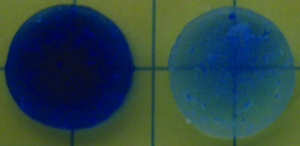by
Lauren Dubinsky, Senior Reporter | June 26, 2014

The hydrogel (right) releases
the chemotherapy drug (left)
in high-dose pulses
Courtesy of Harvard SEAS
and Harvard’s Wyss Institute
Chemotherapy drug delivery systems usually release a continuous dose of the drug over a certain amount of time, but now there is a self-healing hydrogel to deliver the drugs on demand. A study using the gel was recently published in the Proceedings of the National Academy of Sciences.
Researchers at the Harvard School of Engineering and Applied Science (SEAS) and Harvard's Wyss Institute for Biologically Inspired Engineering filled a biocompatible hydrogel with a chemotherapy drug and used ultrasound to temporarily trigger the gel to release short, high-doses of the drug.
With other hydrogels, when the ultrasound is stopped, the gels are destroyed but since the gel the researchers used was self-healing, it was able to be used for the next drug dose. "When we turn it off, the system actually self-heals and the drug delivery rate is reduced back to baseline," Cathal Kearney, co-lead author of the study, told DOTmed News.



Ad Statistics
Times Displayed: 60659
Times Visited: 1939 Ampronix, a Top Master Distributor for Sony Medical, provides Sales, Service & Exchanges for Sony Surgical Displays, Printers, & More. Rely on Us for Expert Support Tailored to Your Needs. Email info@ampronix.com or Call 949-273-8000 for Premier Pricing.
They created the self-healing hydrogel by selecting the right hydrogel, type of drug and ultrasound intensity. The gel is made of alginate, which is a polysaccharide that naturally comes from algae and is held together by calcium ions.
Through a number of tests they revealed that by using a certain level of ultrasound, the bonds break up and allow the gel to release the drug. But since the gel is surrounded by more calcium, it causes the bonds to come back together, causing the gel to self-heal.
After they revealed that, they tried out a chemotherapy drug that is commonly used to treat breast cancer called mitoxantrone. With that combination of hydrogel, chemotherapy drug and ultrasound intensity, the gel released the drug and then reformed after the ultrasound was turned off.
To test it, they used it on mice with implanted human breast cancers. They injected the gel loaded with the drug close to the tumors and then gave the mice a low-level release of the drug and a two and a half minute ultrasound pulse every day for six months.
They found that the mice treated with ultrasound-triggered drug treatment had better outcomes than the mice treated without. The mice who underwent ultrasound survived for an extra 80 days and their tumors did not significantly grow.
"We found that it's more effective at killing the cancer cells," said Kearney.
The researchers believe that this may lead to an improvement in cancer treatment and other therapies since it can give the clinicians the ability to both administer the drug locally and be able to control the dose temporarily.
They also found that the hydrogel can release proteins, which means it can potentially be used for tissue regeneration, and are planning to explore that further. They're also going to investigate other possible applications other than chemotherapy, and the possibility of releasing two different drugs separately using the same hydrogel.
Kearney said that they have a patent on the technology and are interested in talking to companies about it.

